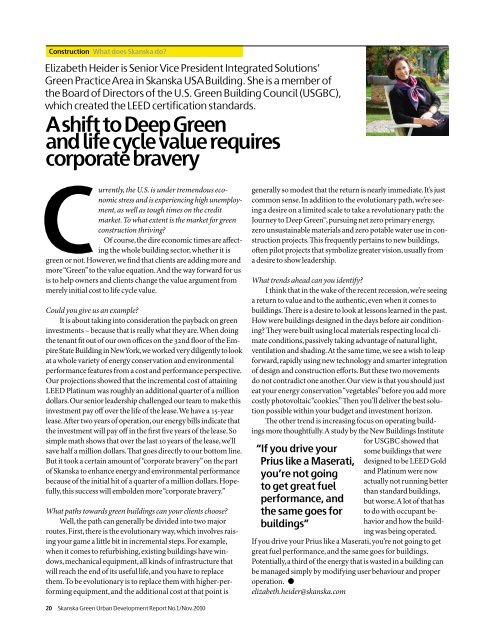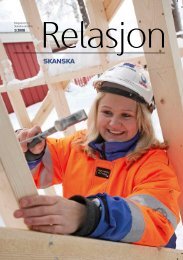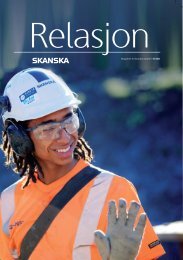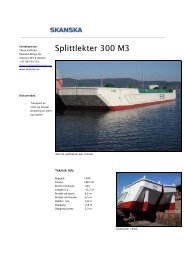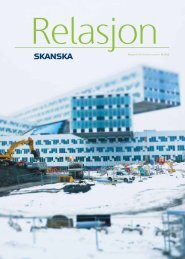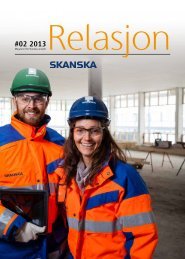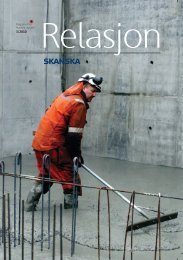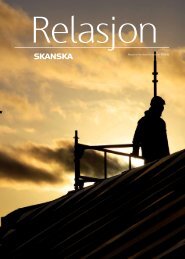Green Urban Development Report No.1 - Skanska
Green Urban Development Report No.1 - Skanska
Green Urban Development Report No.1 - Skanska
Create successful ePaper yourself
Turn your PDF publications into a flip-book with our unique Google optimized e-Paper software.
Construction What does <strong>Skanska</strong> do<br />
Elizabeth Heider is Senior Vice President Integrated Solutions’<br />
<strong>Green</strong> Practice Area in <strong>Skanska</strong> USA Building. She is a member of<br />
the Board of Directors of the U.S. <strong>Green</strong> Building Council (USGBC),<br />
which created the LEED certification standards.<br />
A shift to Deep <strong>Green</strong><br />
and life cycle value requires<br />
corporate bravery<br />
C<br />
urrently, the U.S. is under tremendous economic<br />
stress and is experiencing high unemployment,<br />
as well as tough times on the credit<br />
market. To what extent is the market for green<br />
construction thriving<br />
Of course, the dire economic times are affecting<br />
the whole building sector, whether it is<br />
green or not. However, we find that clients are adding more and<br />
more “<strong>Green</strong>” to the value equation. And the way forward for us<br />
is to help owners and clients change the value argument from<br />
merely initial cost to life cycle value.<br />
Could you give us an example<br />
It is about taking into consideration the payback on green<br />
investments – because that is really what they are. When doing<br />
the tenant fit out of our own offices on the 32nd floor of the Empire<br />
State Building in New York, we worked very diligently to look<br />
at a whole variety of energy conservation and environmental<br />
performance features from a cost and performance perspective.<br />
Our projections showed that the incremental cost of attaining<br />
LEED Platinum was roughly an additional quarter of a million<br />
dollars. Our senior leadership challenged our team to make this<br />
investment pay off over the life of the lease. We have a 15-year<br />
lease. After two years of operation, our energy bills indicate that<br />
the investment will pay off in the first five years of the lease. So<br />
simple math shows that over the last 10 years of the lease, we’ll<br />
save half a million dollars. That goes directly to our bottom line.<br />
But it took a certain amount of “corporate bravery” on the part<br />
of <strong>Skanska</strong> to enhance energy and environmental performance<br />
because of the initial hit of a quarter of a million dollars. Hopefully,<br />
this success will embolden more “corporate bravery.”<br />
What paths towards green buildings can your clients choose<br />
Well, the path can generally be divided into two major<br />
routes. First, there is the evolutionary way, which involves raising<br />
your game a little bit in incremental steps. For example,<br />
when it comes to refurbishing, existing buildings have windows,<br />
mechanical equipment, all kinds of infrastructure that<br />
will reach the end of its useful life, and you have to replace<br />
them. To be evolutionary is to replace them with higher-performing<br />
equipment, and the additional cost at that point is<br />
generally so modest that the return is nearly immediate. It’s just<br />
common sense. In addition to the evolutionary path, we’re seeing<br />
a desire on a limited scale to take a revolutionary path: the<br />
Journey to Deep <strong>Green</strong>, pursuing net zero primary energy,<br />
zero unsustainable materials and zero potable water use in construction<br />
projects. This frequently pertains to new buildings,<br />
often pilot projects that symbolize greater vision, usually from<br />
a desire to show leadership.<br />
What trends ahead can you identify<br />
I think that in the wake of the recent recession, we’re seeing<br />
a return to value and to the authentic, even when it comes to<br />
buildings. There is a desire to look at lessons learned in the past.<br />
How were buildings designed in the days before air conditioning<br />
They were built using local materials respecting local climate<br />
conditions, passively taking advantage of natural light,<br />
ventilation and shading. At the same time, we see a wish to leap<br />
forward, rapidly using new technology and smarter integration<br />
of design and construction efforts. But these two movements<br />
do not contradict one another. Our view is that you should just<br />
eat your energy conservation “vegetables” before you add more<br />
costly photovoltaic “cookies.” Then you’ll deliver the best solution<br />
possible within your budget and investment horizon.<br />
The other trend is increasing focus on operating buildings<br />
more thoughtfully. A study by the New Buildings Institute<br />
“If you drive your<br />
Prius like a Maserati,<br />
you’re not going<br />
to get great fuel<br />
performance, and<br />
the same goes for<br />
buildings”<br />
for USGBC showed that<br />
some buildings that were<br />
designed to be LEED Gold<br />
and Platinum were now<br />
actually not running better<br />
than standard buildings,<br />
but worse. A lot of that has<br />
to do with occupant behavior<br />
and how the building<br />
was being operated.<br />
If you drive your Prius like a Maserati, you’re not going to get<br />
great fuel performance, and the same goes for buildings.<br />
Potentially, a third of the energy that is wasted in a building can<br />
be managed simply by modifying user behaviour and proper<br />
operation. ●<br />
elizabeth.heider@skanska.com<br />
20 <strong>Skanska</strong> <strong>Green</strong> <strong>Urban</strong> <strong>Development</strong> <strong>Report</strong> <strong>No.1</strong>/Nov. 2010


